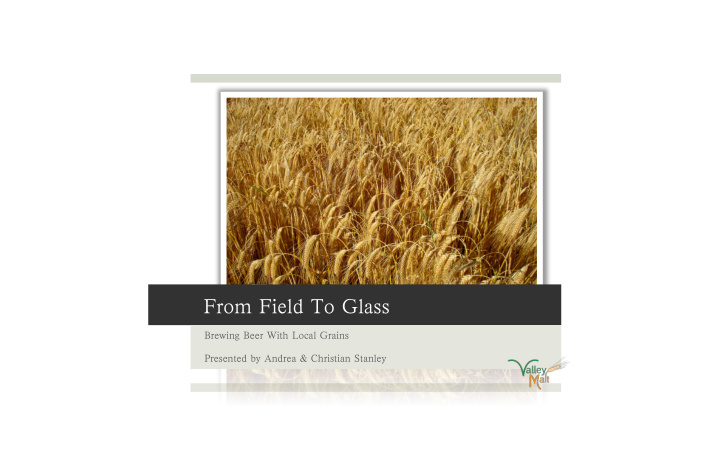



From Field To Glass Brewing Beer With Local Grains Presented by Andrea & Christian Stanley
The Grain of Beer All beer contains malted Barley or malted wheat Some beers use raw, unmalted barley or grain as an adjunct in addition to the malted grain. Malt gives beer color, taste, body, aroma, head, and with yeast alcohol.
The Malting Process Steeping Germination Kilning Additional Kilning or Roasting of Specialty Grains
Maltsters Traditionally a local, value added producer. Regions would have farmers growing barley, maltster and brewers. Since prohibition ended, malt houses have grown to malt factories ‒ minimum batch size on the order of 150,000 pounds at a small facility. Our intention with Valley Malt is to bring malting back to the local level. We are not the only ones, but probably the only ones in the Northeast. On the West Coast, breweries such as Sierra Nevada, and Rogue are looking into growing and malting barley. Small malt houses are also popping up: Rebel Malting in Nevada, and Colorado.
Our Vision Start with a 10 lb, Home Brew system today. Design and build a larger system over the course of the next 6 months to malt grains for the end of the year. Work with farmers and universities to develop compatible varieties for New England, and sustainable farming practices. Release our own beer line at the end of the year utilizing the malted barley that was grown and malted locally.
Barley Grown Today in the US
Barley
Specifications of Malting Barley Criteria Viable For Malting Not Suitable For Malting Kernel Size Plump (6/64”Dia.) - Uniform < 5/64”Diameter Color Light and Tan Dark Brown to Black Fresh ‒ Grainy Odors Moldy Husks In-Tact Cracked or Peeled Endosperm Mealy and White Glassy and Grey Moisture Content 11 - 13.5% > 13.5% Protein Content Low to Moderate (11 - 12.5%) High (>12.5%) Nitrogen Content Low High Germination Rate 95% Viable Kernels < 95% Free of⋯ Disease, FHB, Insects, Chemicals, Frost/Heat Damage
Benefits of Growing Barley Offers erosion control Recycles nutrients Suppresses weed Tilth improving organic matter ‒ Winter variety roots can be over 6’ Can be used as a nurse crop Can be successfully no tilled Prefers a cool, dry growing season Can help to reclaim over worked, weedy or over eroded fields. Can be inexpensive to grow Yield from 2,000 to 3,000 pounds per acre
Malting Barley Varieties Winter Varieties Planted in fall, harvested in summer (9 to 10 month growing season) Could prevent FHB Spring Varieties Planted in spring, harvested in fall (4 to 5 month growing season) Facultative Planted in spring or fall What we see is needed Variety Trials Farmers, Farmers, Farmers Land with Farmers Farmers with combines
Growing Malting Barley Soil Medium texture Loam, clay loam or silty-clay loam ideal Can tolerate slightly acidic soils (> 6.0 pH) Seed Certification and varietal purity Planting Harvesting Shallow (1 in.) seeding into a Must be fully mature firm moist seed bed - early At least 18% moisture (13.5% moisutre 1.5 to 2 Bushels seed per acre/ ideal) 25 plants per square foot Low cylinder speed ‒ check regularly for Thin seeding results in heavy skinned or broken kernels tillering and large heads in Storage seeds Cool, dry, clean ‒ Insect and rodent free Fertilization Less than 70°F Aerated
Malting to Brewing
Detailed Barley Physiology
Recommend
More recommend